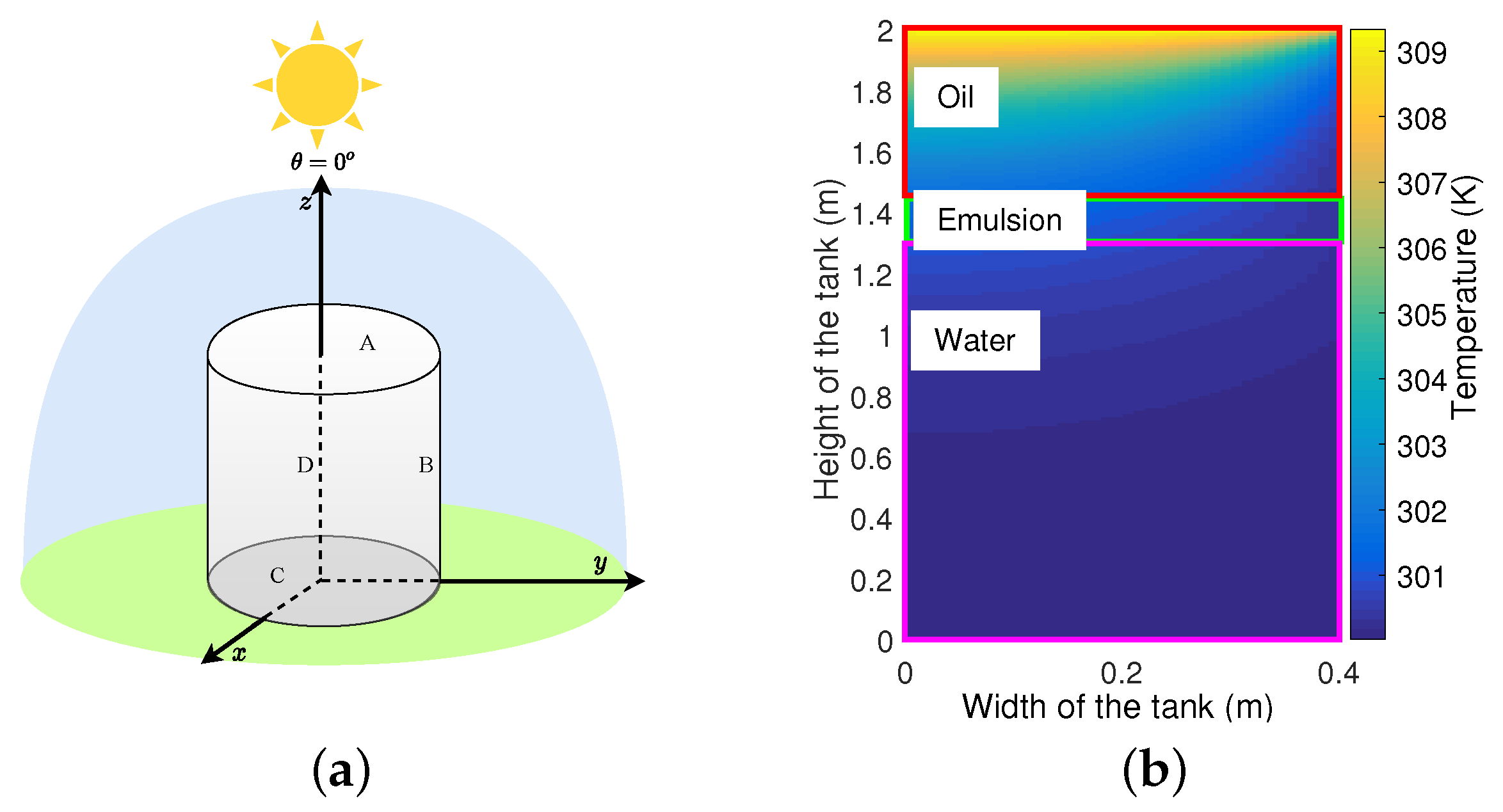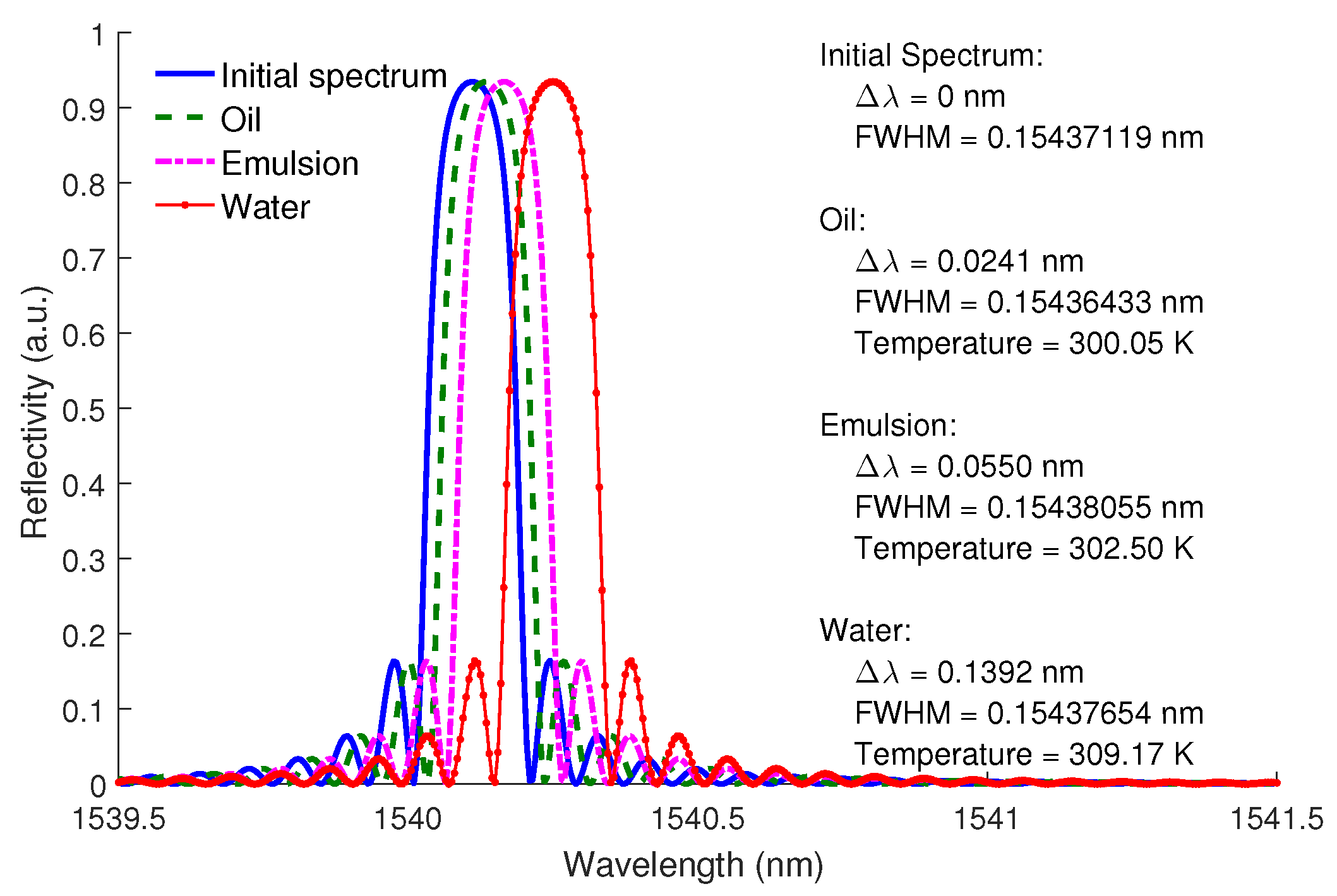Simulation of FBG Temperature Sensor Array for Oil Identification via Random Forest Classification †
Abstract
:1. Introduction
2. Materials and Methods
2.1. Simulation Process
2.2. Random Forest
3. Results and Discussion
4. Conclusions
Author Contributions
Funding
Conflicts of Interest
References
- Leal-Junior, A.G.; Marques, C.; Frizera, A.; Pontes, M.J. Multi-interface level in oil tanks and applications of optical fiber sensors. Opt. Fiber Technol. 2018, 40, 82–92. [Google Scholar] [CrossRef]
- Brockway, P.E.; Owen, A.; Brand-Correa, L.I.; Hardt, L. Estimation of global final-stage energy-return- on-investment for fossil fuels with comparison to renewable energy sources. Nat. Energy 2019, 4, 612–621. [Google Scholar] [CrossRef]
- Atehortúa, C.M.G.; Pérez, N.; Andrade, M.A.B.; Pereira, L.O.V.; Adamowski, J.C. Water-in-oil emulsions separation using an ultrasonic standing wave coalescence chamber. Ultrason. Sonochem. 2019, 57, 57–61. [Google Scholar] [CrossRef] [PubMed]
- Zhang, B.; Kahrizi, M. High-Temperature Resistance Fiber Bragg Grating. Sensors 2007, 7, 586–591. [Google Scholar] [CrossRef]
- Rao, Y.J. Recent progress in applications of in-fibre Bragg grating sensors. Opt. Lasers Eng. 1999, 31, 297–324. [Google Scholar] [CrossRef]
- Da Silva, J.C.C.; Martelli, C.; Kalinowski, H.J.; Penner, E.; Canning, J.; Groothoff, N. Dynamic analysis and temperature measurements of concrete cantilever beam using fibre Bragg gratings. Opt. Lasers Eng. 2007, 45, 88–92. [Google Scholar] [CrossRef]
- Albalate, A.; Minker, W. Semi-Supervised and Unsupervised Machine Learning: Novel Strategies; ISTE Ltd.: London, UK; John Wiley & Sons: Hoboken, NJ, USA, 2011; p. 320. [Google Scholar]
- Fallucchi, F.; Luccasen, R.A.; Turocy, T.L. Identifying discrete behavioural types: A re-analysis of public goods game contributions by hierarchical clustering. J. Econ. Sci. Assoc. 2019, 5, 238–254. [Google Scholar] [CrossRef]
- Dunlop, M.M.; Slepčev, D.; Stuart, A.M.; Thorpe, M. Large data and zero noise limits of graph-based semi-supervised learning algorithms. Appl. Comput. Harmon. Anal. 2019, 1, 1–43. [Google Scholar] [CrossRef]
- Thaisongkroh, P.; Samartkit, P.; Pullteap, S. Applications of optical fiber sensor technology for prioritized industry in Thailand development strategy: A review. In Proceedings of the Seventh International Conference on Optical and Photonic Engineering (icOPEN 2019), Phuket, Thailand, 16–20 July 2019; Volume 11205, p. 1120511. [Google Scholar]
- Proniewska, K.; Pregowska, A.; Malinowski, K.P. Identification of Human Vital Functions Directly Relevant to the Respiratory System Based on the Cardiac and Acoustic Parameters and Random Forest. IRBM 2020, in press. [Google Scholar] [CrossRef]
- Incropera, F.P.; Dewitt, D.P. Fundamentals of Heat and Mass Transfer, 7th ed.; John Wiley & Sons: Hoboken, NJ, USA, 2011. [Google Scholar]
- Prabhugoud, M.; Peters, K. Modified transfer matrix formulation for Bragg grating strain sensors. J. Lightwave Technol. 2004, 22, 2302–2309. [Google Scholar] [CrossRef]
- Lee, T.H.; Ullah, A.; Wang, R. Bootstrap Aggregating and Random Forest; Springer: Cham, Switzerland, 2020; Volume 52, pp. 389–429. [Google Scholar]



Publisher’s Note: MDPI stays neutral with regard to jurisdictional claims in published maps and institutional affiliations. |
© 2020 by the authors. Licensee MDPI, Basel, Switzerland. This article is an open access article distributed under the terms and conditions of the Creative Commons Attribution (CC BY) license (https://creativecommons.org/licenses/by/4.0/).
Share and Cite
Pereira, K.; Lazaro, R.C.; Coimbra de Moraes Junior, W.; Frizera Neto, A.; Leal-Junior, A.G. Simulation of FBG Temperature Sensor Array for Oil Identification via Random Forest Classification. Eng. Proc. 2020, 2, 20. https://doi.org/10.3390/ecsa-7-08177
Pereira K, Lazaro RC, Coimbra de Moraes Junior W, Frizera Neto A, Leal-Junior AG. Simulation of FBG Temperature Sensor Array for Oil Identification via Random Forest Classification. Engineering Proceedings. 2020; 2(1):20. https://doi.org/10.3390/ecsa-7-08177
Chicago/Turabian StylePereira, Katiuski, Renan Costa Lazaro, Wagner Coimbra de Moraes Junior, Anselmo Frizera Neto, and Arnaldo Gomes Leal-Junior. 2020. "Simulation of FBG Temperature Sensor Array for Oil Identification via Random Forest Classification" Engineering Proceedings 2, no. 1: 20. https://doi.org/10.3390/ecsa-7-08177
APA StylePereira, K., Lazaro, R. C., Coimbra de Moraes Junior, W., Frizera Neto, A., & Leal-Junior, A. G. (2020). Simulation of FBG Temperature Sensor Array for Oil Identification via Random Forest Classification. Engineering Proceedings, 2(1), 20. https://doi.org/10.3390/ecsa-7-08177





